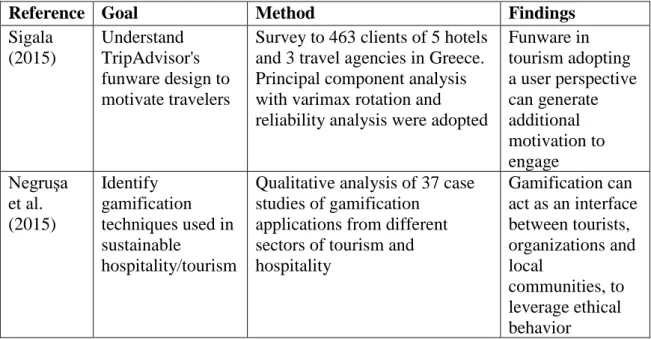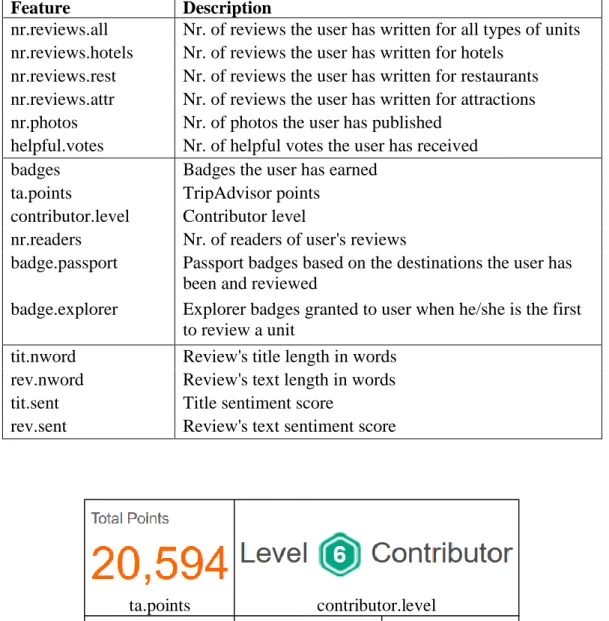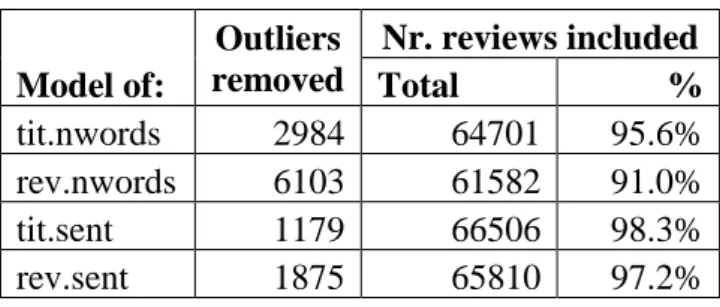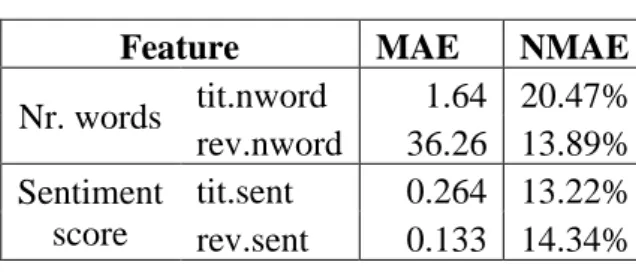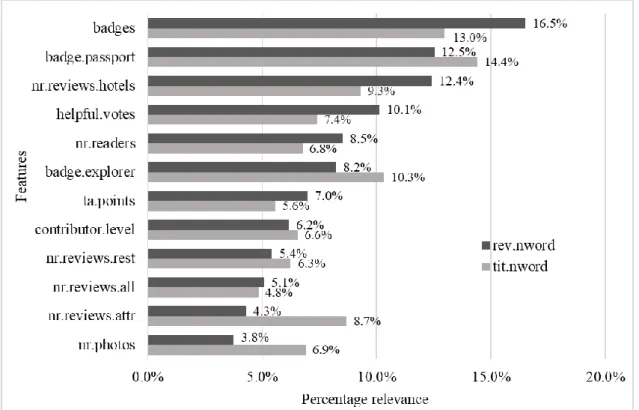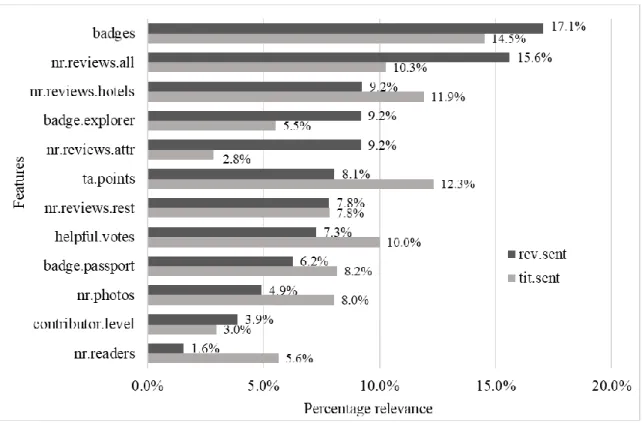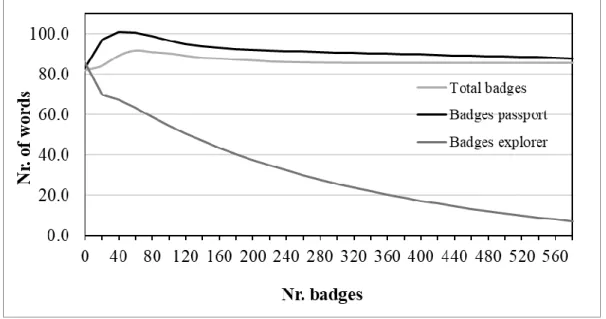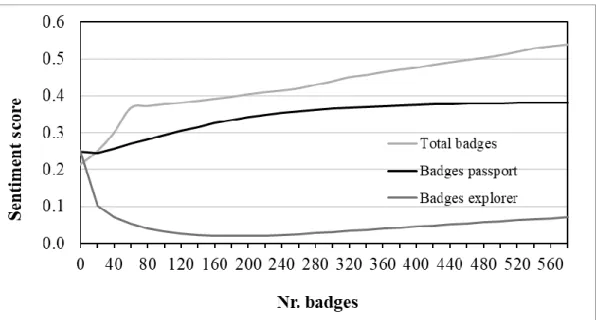Repositório ISCTE-IUL
Deposited in Repositório ISCTE-IUL: 2018-10-15Deposited version: Post-print
Peer-review status of attached file: Peer-reviewed
Citation for published item:
Moro, S., Ramos, P., Esmerado, J. & Jalali, S. M. J. (2019). Can we trace back hotel online reviews’ characteristics using gamification features?. International Journal of Information Management. 44, 88-95
Further information on publisher's website: 10.1016/j.ijinfomgt.2018.09.015
Publisher's copyright statement:
This is the peer reviewed version of the following article: Moro, S., Ramos, P., Esmerado, J. & Jalali, S. M. J. (2019). Can we trace back hotel online reviews’ characteristics using gamification features?. International Journal of Information Management. 44, 88-95, which has been published in final form at https://dx.doi.org/10.1016/j.ijinfomgt.2018.09.015. This article may be used for non-commercial purposes in accordance with the Publisher's Terms and Conditions for self-archiving.
Use policy
Creative Commons CC BY 4.0
The full-text may be used and/or reproduced, and given to third parties in any format or medium, without prior permission or charge, for personal research or study, educational, or not-for-profit purposes provided that:
• a full bibliographic reference is made to the original source • a link is made to the metadata record in the Repository • the full-text is not changed in any way
The full-text must not be sold in any format or medium without the formal permission of the copyright holders.
Serviços de Informação e Documentação, Instituto Universitário de Lisboa (ISCTE-IUL) Av. das Forças Armadas, Edifício II, 1649-026 Lisboa Portugal
Phone: +(351) 217 903 024 | e-mail: administrador.repositorio@iscte-iul.pt https://repositorio.iscte-iul.pt
Can we trace back hotel online reviews’ characteristics using gamification features?
Abstract
Gamification is here to stay, and tourism and hospitality online review platforms are taking advantage of it to attract travelers and motivate them to contribute to their websites. Yet, literature in tourism is scarce in studying how effectively is users’ behavior changing through gamification features. This research aims at filling such gap through a data-driven approach based on a large volume of online reviews (a total of 67,685) collected from TripAdvisor between 2016 and 2017. Four artificial neural networks were trained to model title and review’s word length, and title and review’s sentiment score, using as input 12 gamification features used in TripAdvisor including points and badges. After validating the accuracy of the model for extracting knowledge, the data-based sensitivity analysis was applied to understand how each of the 12 features contributed to explaining review length and its sentiment score. Three badge features were considered the most relevant ones, including the total number of badges, the passport badges, and the explorer badges, providing evidence of a relation between gamification features and traveler’s behavior when writing reviews.
Keywords
Gamification; hotels; online reviews; sentiment analysis; hospitality; neural networks.
1. Introduction
Gamification has emerged as a powerful tool to provide an appealing environment through game-like features to build user attachment (Werbach & Hunter, 2012). Those features, which may include points or attractive badges, aim at exerting on each individual the desire to fulfill the needed accomplishments to be rewarded through recognition (Hamari & Koivisto, 2015). Gamification has been adopted in a wide array of contexts such as education, e-commerce, health, engineering, human resources, and
tourism and hospitality, among others (Hamari et al., 2014; Serna et al., 2017; Araújo & Pestana, 2017; Liu et al., 2015).
There is a hype surrounding gamification in several businesses (Dale, 2014), but the same does not happen specifically for tourism and hospitality online websites, as it was pointed out by Schuckert et al. (2015), where the authors analyzed the impact of gamification in TripAdvisor. Nevertheless, those platforms clearly bet on this type of features, in an attempt of making them more appealing for users (e.g., Sigala, 2015). TripAdvisor and Airbnb are examples of those platforms, adopting points and badges’ systems to attract travelers to contribute with reviews and services (for the case of Airbnb). Therefore, research is needed to study gamification effects in tourism.
Gamification empirical research traditionally adopts survey-based methods, focusing in a distinct group of characterizable individuals (Hamari et al., 2014). While this approach has the advantage of better framing the results and supporting the corresponding the discussions drawn, it is narrowed to small groups, hindering generalizations (Gosling et al., 2004). Furthermore, many respondents are students, since researchers can easily access and persuade them to answer questionnaires, biasing results (Seaborn & Fels, 2015). This study takes a different step through a data-driven approach based on large volumes of information that were automatically collected from TripAdvisor. Reviews are freely written by travelers and express their direct opinions, without the need to persuade anyone to answer, who may rush anything just to be let alone (Calheiros et al., 2017). Grounded on existing theory, this study raises and develops research hypotheses related to the influence of gamification features on the written online reviews about hotels. These hypotheses are evaluated through a data-driven empirical procedure focused on two specific review characteristics: the word length; and the sentiments expressed in it.
2. Theory and research hypotheses
2.1. Customer feedback and online reviews
Customer engagement and feedback are important issues that no manager can neglect at the risk of failing to understand changes in patterns of consumer behavior (Xu et al., 2017; Zhang et al., 2017). The Web 2.0 in its numerous formats such as social networks
and blogs gave rise to a new generation of consumers avid for writing their opinions, thus influencing others at a worldwide scale only possible due to the massification of Internet access (Newman et al., 2016). The tourism and hospitality industries have been among the first to adopt such consumer-oriented technologies with the development of online platforms specifically focused on the tourist perspective, such as TripAdvisor, and Yelp, among others (Chang et al., 2018; Moro et al., 2018b; Guerreiro & Moro, 2017). Those platforms are designed to capture users’ attention and, consequently, have developed their own gamification features to increase attractiveness and translate it into additional engagement (e.g., more written reviews). The use of gaming features to generate user motivation and desire to use the system is called funware (Zichermann & Cunningham, 2011) and it was highlighted for the case of TripAdvisor by Sigala (2015). The proliferation of online platforms and subsequent adoption of gamification gave rise to research on the subject. Yet, researchers seem to have overlooked gamification in hospitality and tourism until recently. For example, the literature review on empirical studies on gamification by Hamari et al. (2014) shows the proliferation of research on education/learning, intra-organizational systems, work, while also providing evidence for other application contexts, but does not mention anything about tourism/hospitality. In education, the introduction of gamification features has proven to be a valuable asset in keeping students motivated, thus helping in building success (e.g., Simões et al., 2013). In fact, education is one of the most prolific domains for gamification research, with a query by “(education OR learning) AND gamification” in Scopus returning more than 1700 hits, showing the finding by Hamari et al. (2014) is still valid today. In contrast, querying Scopus by “(tourism OR hospitality) AND gamification” merely returns less than 30 articles (as of May 2018). These results provide evidence that there is still plenty of road to cover in researching and framing gamification applied to tourism and hospitality.
2.2. Gamification in tourism and hospitality
Table 1 shows five empirical studies on gamification in tourism and hospitality, three of them published in 2015, and the remaining two in 2017. From those five, two are based on TripAdvisor, with both studies’ authors recognizing the importance of TripAdvisor’s gamification features for the company’s success in capturing attention from travelers’ post experience. Three studies conducted experiments supported by data collected through surveys/questionnaires, while two of them web scraped data from their sources
of analysis. Web scraping is the procedure of automatically crawling a website for collecting data, whether through a specifically developed script, or using tools that perform this task (Canito et al., 2018). There are several advantages of web scraping from an online source when compared to surveys, namely: (1) the information was already freely written by users, who by their own will decided to write their opinions (thus, it just a matter of retrieving it), and (2) the volume of information that can be fetched at high speed (e.g., Schuckert et al., 2015, could collect more than a million reviews for their study – see Table 1). The main disadvantage is that there is no control on the information, it is limited by what is available. Yet, despite the availability of a large number of online sources and the advantages of web scraping, most studies in gamification adopt traditional methodologies based on surveys and statistical methods for data analysis (e.g., Kuo & Chuang, 2016; Feng et al., 2018). Specifically, TripAdvisor, one of the largest tourism/hospitality online reviews website (Moro & Rita, 2018), has only been analyzed by Schuckert et al. (2015), who evaluated the relation between the contributor level and the score granted and number of helpful votes. Instead, our study takes full use of the richness of the written review where the traveler expresses his/her sentiments (Jeong et al., 2018; He et al., 2013) to understand if user’s behavior is associated with gamification features.
Table 1 - Gamification applied to tourism studies.
Reference Goal Method Findings
Sigala (2015) Understand TripAdvisor's funware design to motivate travelers
Survey to 463 clients of 5 hotels and 3 travel agencies in Greece. Principal component analysis with varimax rotation and reliability analysis were adopted
Funware in tourism adopting a user perspective can generate additional motivation to engage Negruşa et al. (2015) Identify gamification techniques used in sustainable hospitality/tourism
Qualitative analysis of 37 case studies of gamification
applications from different sectors of tourism and hospitality Gamification can act as an interface between tourists, organizations and local communities, to leverage ethical behavior
Schuckert et al. (2015)
Examine how virtual badges affect the online behavior of reviewers and readers
A total of 1,181,935 reviews were web scraped from TripAdvisor from several locations. Correlation analysis between contributor badge level and review score/helpful votes
Reviewers with high-level badges tend to post moderate ratings and avoid extreme ratings Yoo et al. (2017) Discover the factors influencing smart tourism applications adoption based on Google Maps
Survey to 315 Koreans using mobile applications. Then, a structural equation model was obtained with the gathered data
Gamified smart tourism
applications are regarded as a low-level gaming tool Liang et al. (2017) Analyze gamification design developed by Airbnb of the Superhost badge 3830 accommodation offers of Hong Kong were web scraped. A regression model was applied with 2 independent variables (Superhost; price) and 2 dependent (nr. reviews; rating)
An accommodation with the “Superhost” badge is more likely to receive reviews and higher ratings
2.3. Influence of gamified features in online reviews
Users can play two important roles in online review platforms: as consumers, by reading the opinions that other users have previously written (Zhang et al., 2014), and as reviewers, by writing their own reviews that will be available to be read by others (Davis & Agrawal, 2018). Both roles are interconnected, as it happens often that a user searches for others’ opinions before making his/her own purchase, while after the acquisition the user decides to freely write his/her own opinion (Lee et al., 2013). Gamification features can amplify the consumer effect, as reviewers gain reputation at the eyes of readers by being considered more experienced and reliable sources of information (Schuckert et al., 2015). Likewise, gamification features can be viewed by reviewers as a status achievement and online review platforms can develop such features to encourage a desired behavior (Insley & Nunan, 2014). Yet, little is known about the effect of gamification features on the reviewers. Therefore, we postulate that: H1: A user writing an online review about a hotel is influenced by the gamification features of the adopted online review platform.
Gamification features have been introduced in utilitarian games to encourage players’ behavior toward rewards in distinct contexts such as learning and human resource
management (Hamari & Keronen, 2017). The same types of visually appealing features were adopted by online platforms such as Amazon with the goals to encourage participation while at the same time increase the platform’s overall reputation (Insley & Nunan, 2014). These features are perceived as status achievements, overshadowing simple interaction counters such as the number of reviews (Baek et al., 2012). Nevertheless, such difference has not been measured before. As such, we posit that: H2a: Visually appealing gamification features such as badges have a stronger effect on the review’s length than simpler interaction counters.
H2b: Visually appealing gamification features such as badges have a stronger effect on the sentiment charge of the written review when compared to simpler interaction counters.
Kuan et al. (2015) evaluated review voting based on online reviews from Amazon. They state that “longer reviews are visually more salient and less likely to be overlooked when compared to shorter reviews” (p. 52). Additionally, the same study found that the “top reviewer” Amazon badge is also related to an increased visibility. Yet, the abovementioned authors did not try to compare both. Thus, we can argue that:
H3: Users with more badges tend to write longer reviews.
Hotel reviews were found to be more helpful if those were written by reviewers with more badges (Hu & Chen, 2016). Likewise, the same study corroborates that helpful reviews tend to have an increased sentiment charge but only if the review’s visibility is added to the model. On the other hand, Kuan et al. (2015) discovered that specifically negative sentiment reviews are considered more helpful than the remaining (neutral and positive). Thus, current literature is not consistent regarding the sentiment score. We intend to clarify such issue regarding gamification features (previous studies have focused on review helpfulness). As such, we postulate that:
H4: Users with more badges tend to write reviews with a higher sentiment charge (absolute sentiment score).
3. Data and approach
The data required for this data-driven study was directly collected from TripAdvisor between 2016 and 2017 using a web scraping script specifically developed in the R statistical language, based on the “rvest” package. Tourists are highly influenced by
brand destinations and often their reviews can reflect that, with different locations capturing travelers’ emotions differently (Neirotti et al., 2016). In this study, to remove such brand destination variability effect, a specific location was chosen, Las Vegas. While this renowned gaming and pleasure US destination is a tumultuous city, circumscribing the results, by that same reason, it offers a large set of sentiment charged reviews, which is essential to build a model that explains a larger range of sentiment scores. Additionally, Hu and Chen (2016) took a similar research path by choosing Las Vegas and Orlando because those are two popular destinations, offering a large number of reviews required for a data-driven study. Specifically, this study used the same 21 hotels analyzed by Moro et al. (2017), all located on the Strip, its most famous Avenue where the largest resorts including casinos are located. However, while the previously mentioned authors conducted a manual data collection procedure, in this study we take advantage of web scraping to build a large volume dataset, consisting in 67,685 reviews from 2016 to 2017.
Gathering all the needed information per review requires to issue two requests to TripAdvisor’s website, besides the usual crawling procedure per pagination: first, to access the user profile (e.g., https://www.tripadvisor.com/members/<user_id>); and second, to access the badge webpage for that user (e.g., https://www.tripadvisor.com/members-badgecollection/<user_id>). Table 2 summarizes all the 12 collected and additional, the review title and text. The first six features are counters that directly reflect users’ interactions, while the next six are specific gamification features rewarding users. Figure 1 shows the aspect of five gamification features, while “badges” reflects another direct counter of the number of badges the user has received. The last four features are computed based on review’s title and text. The length is a direct counter of review length in words. The sentiment score is computed through sentiment analysis, which encompasses techniques under the natural language processing (NLP) spectrum that deal with the semantical analysis of human language (Moro et al., 2018a). One of the most widely applied sentiment analysis tasks is to compute the sentiment score. Thus, sentiment analysis discerns the emotional charge concealed in a sentence based on relevant words such as adjectives and adverbs (Ragini et al., 2018). The sentiment score was computed using the “sentimentr” package from the R statistical tool, with 0 (zero) representing a neutral sentiment, and both polarities reflecting negative/positive sentiments.
Table 2 - Features collected from TripAdvisor.
Feature Description
nr.reviews.all Nr. of reviews the user has written for all types of units nr.reviews.hotels Nr. of reviews the user has written for hotels
nr.reviews.rest Nr. of reviews the user has written for restaurants nr.reviews.attr Nr. of reviews the user has written for attractions nr.photos Nr. of photos the user has published
helpful.votes Nr. of helpful votes the user has received badges Badges the user has earned
ta.points TripAdvisor points contributor.level Contributor level
nr.readers Nr. of readers of user's reviews
badge.passport Passport badges based on the destinations the user has been and reviewed
badge.explorer Explorer badges granted to user when he/she is the first to review a unit
tit.nword Review's title length in words rev.nword Review's text length in words tit.sent Title sentiment score
rev.sent Review's text sentiment score
Figure 1 - Badges and points' features collected (below the corresponding names from Table 2).
ta.points
nr.readers badge.passport badge.explorer contributor.level
The last four features from Table 2 are the four dependent variables that we hypothesize that are influenced by the first twelve features. We chose to model also title’s length and sentiment score, since the title can show immediately the reviewer’s experience through a few words combined (Ludwig et al., 2013). Understanding the influence of each of those twelve features requires computing four models using each of the four dependent variables. Since these models are guided by those four variables, supervised learning techniques are required to build them. There are plenty of possibilities, from the most traditional ones such as linear regression and decision trees, to the most advanced ones that are able to apprehend non-linear relations between input variables, such as support vector machines and neural networks (Moro et al., 2014). In our case, the technique chosen for building such models is the multilayer perceptron, the most widely disseminated type of neural network consisting in one input layer, fed by the input features, one hidden layer, composed of a large number of neurons, and one output layer (Hastie et al., 2008). This technique has shown superior performance when compared to the remaining in several problems (e.g., Moro et al., 2014; Osowski et al., 2004). However, in any data mining modeling technique, outliers can affect the algorithm’s capability of modeling since extreme values affect model’s accuracy (Campos et al., 2005). Thus, we plotted boxplots for each of the four dependent variables (Figure 2). As it can be observed, there are several outliers that need to be removed before proceeding in computing each of the four models.
Title’s nr. words Review’s nr. words Title’s sentiments Review’s sentiments
Figure 2 - Boxplots for the four studied characteristics.
Table 3 shows the result of the outlier removal process. For the four cases, the number of reviews after the process is still sufficiently large to proceed with modeling – in all, the final dataset maintains more than 90% of the 67,685 initial reviews.
Table 3 - Outlier removal.
Model of: Outliers removed Nr. reviews included Total % tit.nwords 2984 64701 95.6% rev.nwords 6103 61582 91.0% tit.sent 1179 66506 98.3% rev.sent 1875 65810 97.2%
To assure independency and robustness in modeling and subsequent evaluation of the trained model, we adopted a k-fold cross-validation scheme, which splits the dataset into k equally sized folds, leaving one out for validation while using the remaining for training the model, and rotating across the k folds. Thus, all reviews are used once for testing, and k-1 times for modeling. As recommended by Refaeilzadeh et al. (2009), k was set to 10. Two metrics were adopted for validating the model: the mean absolute error (MAE), which measures the absolute difference between the real and the estimated value (computed by the model), and the normalized MAE, which is the absolute error divided by the amplitude (maximum minus minimum), thus computing a percentage error. Both were adopted and are explained in detail in Silva et al. (2018)’s study. After successfully achieving accurate models, we adopted the data-based sensitivity analysis (DSA) for extracting knowledge from each model in the form of individual feature’s relevance. This technique uses a randomly selected sample from the dataset to assess outcome’s sensitivity to simultaneously varying the input features (Cortez & Embrechts, 2013).
All the data mining experiments were implemented using the “rminer” package (Cortez, 2010) from the R statistical tool, which provides a simple and coherent set of functions easy to use (e.g., training the multilayer perceptron; DSA).
4. Results and discussion
Table 4 shows the performance metrics for the four models, grouped by target (nr. of words in title and review; and sentiment score of title and review text). NMAE values show the models constitute good approximations to model review length and sentiment, although the title length exhibits worse performance, above 20%. These metrics provide support for concluding that it is possible to trace back these two review properties, length and sentiment score, considering only reviewer characteristics such as simple interactions’ counters and others related to gamification (i.e., user points and badges). Therefore, H1 is confirmed. Our study is the first to discern that the reviewer is influenced by gamification features at the time he/she is writing a review. Such finding adds to existing knowledge that gamification increases reputation from readers’ perspective (Schuckert et al., 2015). Thus, there seems to exist a snowball effect in a sense that reviewers rewarded with badges and points for written reviews apparently change their behavior as the accumulated experience translates into more gamification features. Further research is required to ascertain such reviewer’s perspective in other contexts besides hospitality.
Table 4 - Models' performance metrics.
Feature MAE NMAE
Nr. words tit.nword 1.64 20.47% rev.nword 36.26 13.89% Sentiment score tit.sent 0.264 13.22% rev.sent 0.133 14.34%
The DSA reveals the importance each feature has on modeling each of the four goals (Silva et al., 2018). The contribution of each feature is quantified through a percentage, with all features summing 100%, thus enabling to directly compare individual features. We paired the models according to its goals, i.e., length, and sentiment score.
Figure 3 exhibits the relevance of features to both title and review text lengths. There is a concordance in most features’ relevance between title and review. Interestingly, the two most relevant variables in explaining text and title review length are to gamification features. The number of badges the user has received is the most relevant to explain text review length (16.5% of relevance), while it is the second most relevant for title length (13.0% of relevance). Both combined conceal a relevance of almost 30%, showing the
power of gamification in user behavior patterns in the hospitality industry. Additionally, the explorer badge, granted for each first review ever of a unit, is the third most relevant feature to title length, with a relevance above 10%, while also holding a relevance of 8.2% for text review length. Such result emphasizes TripAdvisor’s badges relevance in influencing users. In comparison, the number of reviews’ counters have a less relevant role. Thus, we confirm H2a. This result corroborates the power of gamification to change users’ behavior (Hamari & Keronen, 2017). Online review platforms can use such knowledge to shape users by building clusters of influential consumers who may then help in building the visibility of the platform itself (Guerreiro & Moro, 2017).
Figure 3 - Features relevance for the nr. of words length of review text and title.
The relevance of each feature to the sentiment score computed from both title and text reviews is shown on Figure 4. Unlike with length, there is an apparent discordance for some features between title and text. Yet, the most relevant variable remains the number of badges, strengthening the importance of this gamification feature. The number of reviews for all types (i.e., hotels, restaurants, and attractions) and the specific number of hotel reviews are the next two combined features holding a high percentage of relevance for the sentiments expressed in both title and review text. Therefore, H2b is only partially confirmed. Unlike the review’s length, which was shown to be highly
influenced by badges, the sentiments expressed are mostly influenced by the experience during the visitor’s stay (Jiménez & Mendoza, 2013), even though the experience as a TripAdvisor member can have a significant impact (as it was found by Moro et al., 2017), which is translated into our findings by the high relevance of the number of reviews’ counters.
Figure 4 - Features relevance for the sentiment score of review text and title.
Next, we examine closely how each of the three most relevant gamification features influences both title/review length and sentiment score. This includes the number of badges, the explorer badges, and the passport badges (Table 5).
Table 5 - Combined relevance of the three most relevant gamification features.
Feature Length Sentiment score
Title Text Title Text
badges 13.0% 16.5% 14.5% 17.1%
badge.passport 14.4% 12.5% 8.2% 6.2% badge.explorer 10.3% 8.2% 5.5% 9.2% 37.7% 37.3% 28.2% 32.5%
The next figures are obtained using the variable effect characteristic curve based on the DSA computed importance as implemented by the “rminer” package, in a similar procedure to what Moro et al. (2017) did. The features influence is scrutinized aggregated by goal (i.e., title length, text length, title sentiment score, and text sentiment score).
Figure 5 shows how the three most relevant gamification features influence title length as measured by the number of words. Most titles are short in length, consisting in one to five words. The passport badges almost overlap the total number of badges, with users having more than 60 badges increasing title length from 3/4 words to 5. A more experienced traveler, translated by more than 20 passport badges, also tends to write 5-word titles. The explorer badges, which are granted for first ever reviews to any unit, provide hints on the power of gamification: travelers eager to be the first ever in reviewing a unit, quickly type a shorter title.
Figure 5 - Influence of badges on title’s number of words.
The influence of the three badges’ features on review length is exhibited in Figure 6. It confirms the results from title length, as the total number of badges and the passport badges almost overlap, while a higher number of explorer badges implies much shorter reviews, helping to support our previous claim that the users are incentivized to be the first to submit a review to a unit through this gamification feature. Yet, there is a hill effect observed for passport badges between 30 to 60 of those badges, while a similar but smaller effect is also observed for the total number of badges. This is an evidence of travelers’ response to the appeal of passport badges, since after the traveler is granted
some badges, he/she appears to respond to such incentive by devoting more time in writing longer reviews. Excluding the discussed specificity associated with the explorer badge which happens to be the least relevant badge when considering review length (Table 5), the two most significant badges have a positive influence in review’s length until a threshold of around 60 badges. Such result corroborates H3 for novice to medium-level users. Yet, after that number of badges, title length is not affected, while the text length slightly decreases. Thus, H3 is only partially supported, suggesting the existence of gamification attrition. A question remains unanswered: how are online review platforms motivating experienced users to keep contributing with reviews? Our finding calls for future research to specifically target such cluster of users, who may also be influenced by different features.
Figure 6 - Influence of badges on text’s number of words.
Figures 7 and 8 exhibit the three badges effect on the sentiments expressed in the title and the review text, respectively. The first interesting to note concerns the explorer badge: the higher the number of this type of badge, the closer the sentiments expressed in both title and text is to zero, i.e., the more neutral are the sentiments expressed. Therefore, this result emphasizes previous finding that travelers with a lot of explorer badges tend not only to write shorter reviews, but also reviews lacking emotions which would require longer time to express and thus, users would risk further in being the first and being accordingly awarded with the badge. Easley and Ghosh (2016) pointed out that “the value from winning a badge depends endogenously on the number of other winners” (p. 1). This type of “being the first” badge is drawn to incentivize competition
among travelers, since it is a badge only granted once per unit. Thus, accomplishing it unleashes in the user a sense of victory that has motivated the race to rush a quick review, reflected in the absence of emotion in the poorly selected words written. While there is currently research analyzing the types of badges on other contexts, (e.g., education: Ruipérez-Valiente et al., 2017), clearly there is a need for more research to understand the effects of the types of badges on tourism and hospitality. This emphasizes the call made by Sigala (2015) to further research in the effects of the different types of funware.
Regarding the total badges and passport badges influence on the expressed sentiments, unlike for title and review lengths, there is not an overlap of both gamification features. The total badges, i.e., the most relevant feature for the built models, is amplified until around 60 badges, with new users feeling impelled by this feature to express their feelings. After that plateau, users still increment the expressed sentiments in the title, although the same does not happen for the review text. Although H2b was only partially confirmed, badges still have shown to be valuable predictors to the expressed sentiments (Table 5). H4 posits that users holding more badges write higher sentiment charged reviews. This hypothesis is only partially supported by the total badges feature until the same threshold of 60 badges verified for review length, and by the passport badges for the title (Figures 7 and 8). Specifically, experienced travelers tend to express less positive sentiments (here reflected by the passport badge), which is consistent with current literature since experienced travelers are more demanding and have higher expectations of their traveling experiences (Anderson et al., 2008). Thus, having more passport badges reduces the sentiment score to become more neutral. Yet, the total badges feature leads us to think that it accounts for other still unchartered factors that need to be individually uncovered to understand their effect on the expressed sentiments.
Figure 7 - Influence of badges on title’s sentiment score.
Figure 8 - Influence of badges on text’s sentiment score.
5. Conclusions and implications
This study confirms the effect of gamification features as tools to incentivize travelers in interacting with TripAdvisor and contributing by writing reviews. The proposed approach, built on data mining encompassing several related features toward achieving an accurate model, has provided useful in supporting such claim. Particularly, by narrowing the destination of analysis to Las Vegas Strip, a renowned travel destination brand, and to 21 hotels there located, the model is not influenced by the destination, which is a known moderator for customer satisfaction. The model, grounded on an
advanced machine learning technique such as neural networks, enabled to confirm that gamification features influence travelers at the time they are writing reviews. Likewise, the model provided evidence that the visually appealing badges affect more review length when compared to simpler interaction counters (e.g., number of reviews). Yet, the same is not totally corroborated for the expressed sentiments, with both badges and counters having a relevant influence in the reviews. In overall, our study uncovered proofs that users receiving badges are influenced to write longer reviews, and that both badges and interaction counters also influence the expressed sentiments, although it was found that different badges affect differently the absolute sentiment score.
However, by being a data-driven study focused on a single tumultuous US city, our findings are limited to the Las Vegas context. Such limitation calls for further research by encompassing different contexts, including not only different locations and continents, but also other platforms and languages.
The question about platforms such as TripAdvisor is: what’s next? If travelers are already eager to submit their reviews, how can TripAdvisor further benefit from its users considering gamification features? Well, this platform can evolve into a network of related travelers, and badges can leverage interactions through credibility and visibility, even furthering users to continuously contribute with reviews. The recently released TripAdvisor forum provides a hint on this community concept which is rising on this platform. Thus, while online reviews platforms such as TripAdvisor help to empower consumers, incentivization mechanisms such as gamification help also in empowering the dominated position of TripAdvisor.
References
Anderson, S., Pearo, L. K., & Widener, S. K. (2008). Drivers of service satisfaction: linking customer satisfaction to the service concept and customer characteristics. Journal of Service Research, 10(4), 365-381.
Araújo, J., & Pestana, G. (2017). A framework for social well-being and skills management at the workplace. International Journal of Information Management, 37(6), 718-725.
Baek, H., Ahn, J., & Choi, Y. (2012). Helpfulness of online consumer reviews: Readers' objectives and review cues. International Journal of Electronic Commerce, 17(2), 99-126.
Chang, Y. C., Ku, C. H., & Chen, C. H. (2018). Social media analytics: Extracting and visualizing Hilton hotel ratings and reviews from TripAdvisor. International Journal of Information Management, DOI:10.1016/j.ijinfomgt.2017.11.001.
Calheiros, A. C., Moro, S., & Rita, P. (2017). Sentiment classification of consumer-generated online reviews using topic modeling. Journal of Hospitality Marketing & Management, 26(7), 675-693.
Campos, M. M., Stengard, P. J., & Milenova, B. L. (2005). Data-centric automated data mining. In Machine Learning and Applications, 2005. Proceedings. Fourth International Conference on (pp. 8-pp). IEEE.
Canito, J., Ramos, P., Moro, S., & Rita, P. (2018). Unfolding the relations between companies and technologies under the Big Data umbrella. Computers in Industry, 99, 1-8.
Cortez, P. (2010). Data mining with neural networks and support vector machines using the R/rminer tool. In Industrial Conference on Data Mining (pp. 572-583). Springer, Berlin, Heidelberg.
Cortez, P., & Embrechts, M. J. (2013). Using sensitivity analysis and visualization techniques to open black box data mining models. Information Sciences, 225, 1-17. Dale, S. (2014). Gamification: Making work fun, or making fun of work?. Business Information Review, 31(2), 82-90.
Davis, J. M., & Agrawal, D. (2018). Understanding the role of interpersonal identification in online review evaluation: An information processing perspective. International Journal of Information Management, 38(1), 140-149.
Easley, D., & Ghosh, A. (2016). Incentives, gamification, and game theory: an economic approach to badge design. ACM Transactions on Economics and Computation (TEAC), 4(3), paper 16.
Feng, Y., Ye, H. J., Yu, Y., Yang, C., & Cui, T. (2018). Gamification artifacts and crowdsourcing participation: Examining the mediating role of intrinsic motivations. Computers in Human Behavior, 81, 124-136.
Gosling, S. D., Vazire, S., Srivastava, S., & John, O. P. (2004). Should we trust web-based studies? A comparative analysis of six preconceptions about internet questionnaires. American Psychologist, 59(2), 93-104.
Guerreiro, J., & Moro, S. (2017). Are Yelp's tips helpful in building influential consumers?. Tourism Management Perspectives, 24, 151-154.
Hamari, J., & Keronen, L. (2017). Why do people play games? A meta-analysis. International Journal of Information Management, 37(3), 125-141.
Hamari, J., & Koivisto, J. (2015). Why do people use gamification services?. International Journal of Information Management, 35(4), 419-431.
Hamari, J., Koivisto, J., & Sarsa, H. (2014). Does gamification work? - a literature review of empirical studies on gamification. In System Sciences (HICSS), 2014 47th Hawaii International Conference on (pp. 3025-3034). IEEE.
Hastie, T., & Tibshirani, R. & Friedman, J. (2008). The Elements of Statistical Learning; Data Mining, Inference and Prediction. Springer, New York.
He, W., Zha, S., & Li, L. (2013). Social media competitive analysis and text mining: A case study in the pizza industry. International Journal of Information Management, 33(3), 464-472.
Hu, Y. H., & Chen, K. (2016). Predicting hotel review helpfulness: The impact of review visibility, and interaction between hotel stars and review ratings. International Journal of Information Management, 36(6), 929-944.
Insley, V., & Nunan, D. (2014). Gamification and the online retail experience. International Journal of Retail & Distribution Management, 42(5), 340-351.
Jeong, B., Yoon, J., & Lee, J. M. (2018). Social media mining for product planning: A product opportunity mining approach based on topic modeling and sentiment analysis.
International Journal of Information Management, DOI:
Jiménez, F. R., & Mendoza, N. A. (2013). Too popular to ignore: The influence of online reviews on purchase intentions of search and experience products. Journal of Interactive Marketing, 27(3), 226-235.
Kuan, K. K., Hui, K. L., Prasarnphanich, P., & Lai, H. Y. (2015). What makes a review voted? An empirical investigation of review voting in online review systems. Journal of the Association for Information Systems, 16(1), 48-71.
Kuo, M. S., & Chuang, T. Y. (2016). How gamification motivates visits and engagement for online academic dissemination - An empirical study. Computers in Human Behavior, 55, 16-27.
Lee, S. H., Noh, S. E., & Kim, H. W. (2013). A mixed methods approach to electronic word-of-mouth in the open-market context. International Journal of Information Management, 33(4), 687-696.
Liang, S., Schuckert, M., Law, R., & Chen, C. C. (2017). Be a “Superhost”: The importance of badge systems for peer-to-peer rental accommodations. Tourism Management, 60, 454-465.
Liu, X., Schuckert, M., & Law, R. (2015). Online incentive hierarchies, review extremity, and review quality: Empirical evidence from the hotel sector. Journal of Travel & Tourism Marketing, 33(3), 279-292.
Ludwig, S., De Ruyter, K., Friedman, M., Brüggen, E. C., Wetzels, M., & Pfann, G. (2013). More than words: The influence of affective content and linguistic style matches in online reviews on conversion rates. Journal of Marketing, 77(1), 87-103.
Moro, S., Cortez, P., & Rita, P. (2014). A data-driven approach to predict the success of bank telemarketing. Decision Support Systems, 62, 22-31.
Moro, S., Rita, P., & Coelho, J. (2017). Stripping customers' feedback on hotels through data mining: The case of Las Vegas Strip. Tourism Management Perspectives, 23, 41-52.
Moro, S., & Rita, P. (2018). Brand strategies in social media in hospitality and tourism. International Journal of Contemporary Hospitality Management, 30(1), 343-364.
Moro, S., Pires, G., Rita, P., & Cortez, P. (2018a). A cross-cultural case study of consumers' communications about a new technological product. Journal of Business Research, DOI:10.1016/j.jbusres.2018.08.009.
Moro, S., Rita, P., & Oliveira, C. (2018b). Factors influencing hotels’ online prices. Journal of Hospitality Marketing & Management, 27(4), 443-464.
Negruşa, A. L., Toader, V., Sofică, A., Tutunea, M. F., & Rus, R. V. (2015). Exploring gamification techniques and applications for sustainable tourism. Sustainability, 7(8), 11160-11189.
Neirotti, P., Raguseo, E., & Paolucci, E. (2016). Are customers’ reviews creating value in the hospitality industry? Exploring the moderating effects of market positioning. International Journal of Information Management, 36(6), 1133-1143.
Newman, R., Chang, V., Walters, R. J., & Wills, G. B. (2016). Web 2.0 - The past and the future. International Journal of Information Management, 36(4), 591-598.
Osowski, S., Siwek, K., & Markiewicz, T. (2004). Mlp and svm networks-a comparative study. In Proceedings of the 6th Nordic Signal Processing Symposium (pp. 37-40). IEEE.
Ragini, J. R., Anand, P. R., & Bhaskar, V. (2018). Big data analytics for disaster response and recovery through sentiment analysis. International Journal of Information Management, 42, 13-24.
Refaeilzadeh, P., Tang, L., & Liu, H. (2009). Cross-validation. In Encyclopedia of database systems (pp. 532-538). Springer US.
Ruipérez-Valiente, J. A., Muñoz-Merino, P. J., & Delgado Kloos, C. (2017). Detecting and Clustering Students by their Gamification Behavior with Badges: A Case Study in Engineering Education. International Journal of Engineering Education, 33(2-B), 816-830.
Schuckert, M., Liu, X., & Law, R. (2015). Stars, votes, and badges: How online badges affect hotel reviewers. Journal of Travel & Tourism Marketing, 33(4), 440-452.
Seaborn, K., & Fels, D. I. (2015). Gamification in theory and action: A survey. International Journal of Human-Computer Studies, 74, 14-31.
Serna, E., Bachiller, O., & Serna, A. (2017). Knowledge meaning and management in requirements engineering. International Journal of Information Management, 37(3), 155-161.
Sigala, M. (2015). The application and impact of gamification funware on trip planning and experiences: The case of TripAdvisor’s funware. Electronic Markets, 25(3), 189-209.
Silva, A. T., Moro, S., Rita, P., & Cortez, P. (2018). Unveiling the features of successful eBay smartphone sellers. Journal of Retailing and Consumer Services, 43, 311-324. Simões, J., Redondo, R. D., & Vilas, A. F. (2013). A social gamification framework for a K-6 learning platform. Computers in Human Behavior, 29(2), 345-353.
Werbach, K., & Hunter, D. (2012). For the win: How game thinking can revolutionize your business. Wharton Digital Press.
Xu, X., Wang, X., Li, Y., & Haghighi, M. (2017). Business intelligence in online customer textual reviews: Understanding consumer perceptions and influential factors. International Journal of Information Management, 37(6), 673-683.
Yoo, C., Kwon, S., Na, H., & Chang, B. (2017). Factors Affecting the Adoption of Gamified Smart Tourism Applications: An Integrative Approach. Sustainability, 9(12), 2162.
Zhang, K. Z., Cheung, C. M., & Lee, M. K. (2014). Examining the moderating effect of inconsistent reviews and its gender differences on consumers’ online shopping decision. International Journal of Information Management, 34(2), 89-98.
Zhang, M., Guo, L., Hu, M., & Liu, W. (2017). Influence of customer engagement with company social networks on stickiness: Mediating effect of customer value creation. International Journal of Information Management, 37(3), 229-240.
Zichermann, G., & Cunningham, C. (2011). Gamification by design: Implementing game mechanics in web and mobile apps. O'Reilly Media, Inc.
